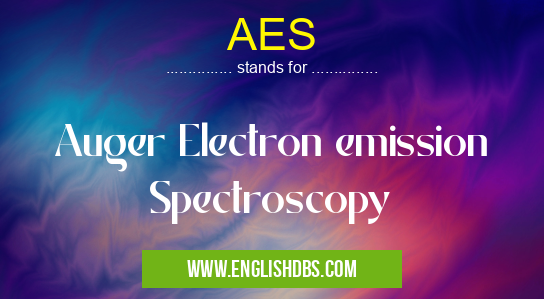What does AES mean in ELECTRONICS
Auger Electron Emission Spectroscopy, often abbreviated as AES, is a type of non-destructive analytical technique used to identify the elements present in a sample. AES is done by measuring the energy of electrons emitted from the sample when it is bombarded with X-rays or electrons. By analyzing these energies, it can be determined which elements are present and the depth at which they are present in the sample.

AES meaning in Electronics in Academic & Science
AES mostly used in an acronym Electronics in Category Academic & Science that means Auger Electron emission Spectroscopy
Shorthand: AES,
Full Form: Auger Electron emission Spectroscopy
For more information of "Auger Electron emission Spectroscopy", see the section below.
Essential Questions and Answers on Auger Electron emission Spectroscopy in "SCIENCE»ELECTRONICS"
How does AES work?
AES works by bombarding a sample with an electron or X-ray source and then analyzing the energy of the electrons that are emitted from the sample. By measuring this energy, it can be determined which elements are present and how deeply they are embedded in the sample.
What are some potential applications of AES?
Some potential applications of AES include scientific research, such as studying how substrate materials interact with thin films; analysis of corrosion on metal surfaces; characterization of semiconductor devices; and inspection of semiconductor wafers for contamination and defects.
What types of samples can be analyzed by AES?
Virtually any type of solid material can be analyzed using AES, including metals, alloys, polymers, ceramics, semiconductors, composites, minerals, and biological materials.
What kind of information does an AES analysis provide?
An AES analysis provides information about the elemental composition and distribution in a sample. Additionally, it can provide information about local oxidation states, surface contamination levels, and chemical bonding between different species in a material.
Are there any limitations to using AES to analyze samples?
Yes - due to its non-destructive nature and low cost compared to other elemental analysis techniques like ICP-MS or NMR spectroscopy, there are some limitations to using AES without additional analytical techniques such as XPS or ToF-SIMS. It cannot measure trace amounts of elements (<100ppm) or provide detailed structural information about molecules within a sample (e.g., molecular weight).
Final Words:
Auger Electron Emission Spectroscopy (AES) is an invaluable tool for scientific research thanks to its ability to analyze virtually any type of solid material quickly and accurately without consuming or damaging the sample itself. Despite its limitations — related mainly to trace elements or providing structural information — it has proven invaluable for characterizing electronic devices and materials for industrial use as well as determining local oxidation states within complex materials like polymers or composites.
AES also stands for: |
|
| All stands for AES |
